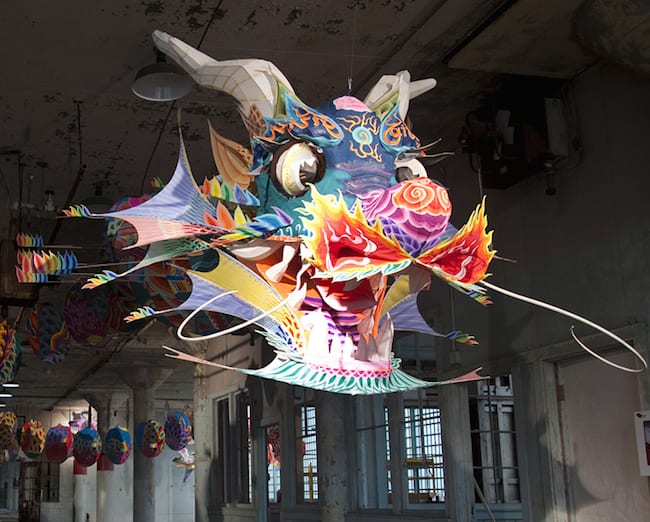“The misconception of totalitarianism is that freedom can be imprisoned. This is not the case. When you constrain freedom, freedom will take flight and land on a windowsill.” — Ai Weiwei
If there is any lingering doubt about Ai Weiwei’s genius as an art phenomenon, @Large: Ai Weiwei on Alcatraz (San Francisco, Alcatraz Island, September 27, 2014 – April 26, 2015) dispels those concerns. The show is a magnificent statement on about 20 different levels and is as sly as a devil. Even without the pointed human rights issues and barbs directed against the Chine regime in Ai’s art, all one has to read is “Ai Weiwei on Alcatraz” and then note the fact that he cannot attend his own exhibition, and the job is done.



Ai Weiwei, With Wind, 2014, at the New Industries building, Alcatraz. Photographs by Jan Stürmann.
When is China going to realize that by preventing Ai from traveling that are giving him a mightier sword than if he were free? But then totalitarianism does as totalitarianism is.

Ai Weiwei, With Wind, 2014, at the New Industries building, Alcatraz. Photograph by Jan Stürmann.
Ai’s seven sculptures, sound and mixed-media installations occupy four locations in the former prison: the New Industries Building, a group of cells in A Block, the Hospital and the Dining Hall. With the exception of the Dining Hall, these areas are usually restricted to the public, but all are open throughout the run of the exhibition.



Ai Weiwei, Refraction, 2014, at the New Industries building, Alcatraz. Photographs by Jan Stürmann.
@Large turns Alcatraz into a space for dialogue about how we define liberty and justice, individual rights and personal responsibility. In artworks that balance political impact with aesthetic grace, the exhibition directly and imaginatively addresses the situation of people around the world who have been deprived of their freedom for speaking out about their beliefs — people like Ai himself.

Ai Weiwei, Stay Tuned, 2014, in the A-block of Alcatraz. Photograph by Jan Stürmann.

Ai Weiwei, Yours Truly, 2014, in the Alcatraz dining hall. Photograph by Jan Stürmann.
This post will focus on two the seven installations, both dealing with ceramics, the subject that Ai claims to hate and which he cannot keep his hands off of. You can visit the other installations online at the FOR-SITE Foundation. The organizers note that:
“Unable to visit Alcatraz during the planning of this exhibition; he has developed the artwork at his studio in Beijing, with the help of the FOR-SITE Foundation. Ai has embraced the ironies of creating site-specific art for a place he couldn’t see, and of celebrating free expression while working under severe constraints. Conflict and struggle have only galvanized the artist’s commitment to art as an act of conscience. With this project, he aims to expand our understanding of ‘the purpose of art, which is the fight for freedom.'”

Ai Weiwei, Blossom, 2014, in the Alcatraz hospital. Photograph by Jan Stürmann.
In Blossom, Ai Weiwei quietly transforms the utilitarian fixtures in several hospital ward cells and medical offices into fragile porcelain bouquets. The artist has designed intricate encrustations of ceramic flowers to fill the sinks, toilets and tubs that were once used by hospitalized prisoners.



Ai Weiwei, Blossom, 2014, at the Alcatraz hospital. Photographs by Jan Stürmann.
Like With Wind in the New Industries Building, Blossom draws on and alters natural imagery as well as traditional Chinese arts. However, the flowers here carry other associations. The work could be seen as symbolically offering comfort to the imprisoned, as one would send a bouquet to a hospitalized patient. The profusion of flowers rendered in a cool and brittle material could also be an ironic reference to China’s famous Hundred Flowers Campaign of 1956, a brief period of government tolerance for free expression that was immediately followed by a severe crackdown against dissent.


Ai Weiwei, Blossom, 2014, at the Alcatraz hospital. Photographs by Jan Stürmann.
One of the most haunting spaces in the prison — a pair of ceramic tiled chambers in the Hospital, once used for the isolation and observation of mentally ill inmates — resonates with the sound of Tibetan and Native American chanting in this austere and moving installation. The Tibetan chant is a Buddhist ceremony for the goddess Palden Lhamo, protectress of Tibet; it was recorded at the Namgyal Monastery in Dharamsala, India, a monastery historically associated with the Dalai Lama.


The Alcatraz psychiatric observation room, the site of Ai Weiwei’s sound installation Illumination, 2014. Photographs by Jan Stürmann.
The Hopi music comes from a traditional Eagle Dance invoking the bird’s healing powers. Hopi men were among the first prisoners of conscience on Alcatraz, held for refusing to send their children to government boarding schools in the late 19th century. For information about Hopi prisoners on Alcatraz, visit the National Park Service website.


The psychiatric observation room at Alcatraz, the site of Ai Weiwei’s sound installation Illumination, 2014. Photographs by Jan Stürmann
This is another statement about Ai Weiwei’s growing closeness to American Indians coming soon after his collaboration with Bert Benally at Coyote Canyon in the Navajo Nation that CFile took part in and reported on earlier this year.

Hopi inmates of Alcatraz.
CFile will be revisiting this exhibition later in the year.
Garth Clark is the Chief Editor of CFile.


Powerful yes, beautiful and so sad. The artwork then the images. Especially with the beautiful Hopi Indians being incarcerated at that time.
This is so powerful, in particular the flowers,